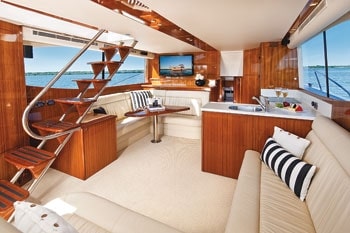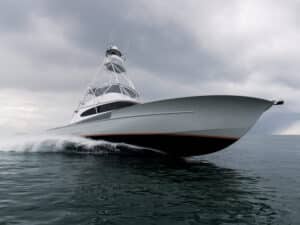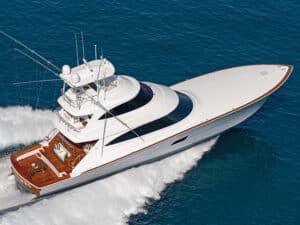A highly regarded sport-fishing boatbuilder once confided to me that only one-third of the owners of sport-fishing convertibles actually seriously fish. (He defined serious as those who fish the tournament circuit.) He qualified another third as good recreational anglers who both fished and cruised, and the final third never wet a line at all. Interestingly, this latter group that only cruised still more often than not would outfit their boats with gear serious anglers consider obligatory – towers, fighting chairs and outriggers – to stack the resale odds in their favor.
Of course, the term convertible itself refers to a vessel able to convert from fishing machine to cruiser. The more I thought about it, the less surprising this revelation seemed. The essence of a good convertible design – one with a functional cockpit, good speed, sound and seaworthy performance characteristics, comfortable accommodations and pleasing aesthetics – ought to appeal to a range of boaters beyond those anglers battling it out for the next grander.
Australian builder Maritimo’s newest midsize model – the 470 – certainly appeals to all three segments. But fortunately for dedicated offshore anglers, it performs extremely well as a fishing platform.
Based on the successful 500 and 550 Offshore models, the well-engineered 470 proved to be a solid performer with creature comforts that make running far afield in search of big game luxuriously palatable.
**Bridge
**The 470 features the builder’s trademark enclosed bridge and internal staircase – an excellent feature both for those who dislike the potential insecurity of climbing an external flybridge ladder and those who like staying dry and warm in less than ideal conditions. It’s not easy to incorporate both design elements into a boat of less than 60 feet without having it look like an afterthought. In my opinion, Maritimo pulled it off remarkably well.

I know captains who dislike fishing enclosed-bridge boats because they feel cut off from the fishing or don’t like having to change helm stations in the midst of a hookup. Consider these concerns irrelevant on the 470. The unusual three-sided enclosed bridge (Strataglas aft curtains complete the bridge enclosure) is well-suited for both fishing and getting where you’re going, with an aft helm overlooking two-thirds of the cockpit, and an L-shaped settee forward of the helm, which allows guests to look ahead over the bow. Equipped with a table, the bridge also makes a perfect place for happy hour after a day on the water. A single seat is on the portside, and a sink is aft and to port. And once you open the electric sunroof, the area feels just as open as any open-flybridge design, in my opinion.
The 470 benefits from trickle-down technology coming from Maritimo’s offshore racing boat success, where gauges, electronics and engine controls must be perfectly positioned to react and adjust at speeds well in excess of 100 knots. The 470 features a three-panel dash with room on each end for a 15-inch monitor, and the engine gauges and various breakers are placed on the center panel, just below the compass.
**Belowdecks
**The salon’s functional layout dedicates equally generous space to the galley, dinette and seating area. And between dry storage throughout the boat and the pantry flanking the staircase, an extra refrigerator on the portside and additional lockers in the galley, this 47-footer provides more than enough stowage to stock up for at least a month in the Bahamas or Mexico.
I particularly liked the sophisticated yet simple interior, which you select from among several interior woods in various finishes. Our test boat featured teak with a matte finish – good for hiding fingerprints. Forward you’ll find three staterooms and two heads, with each stateroom benefiting from swaths of natural light. I had a tough time deciding if the amidships or forward stateroom qualified as the master. They both have en suite heads and are equally spacious. A single stateroom resides to starboard.
**Performance
**Nice appointments, joinery and cruising comfort are just part of the story. The real difference between the 470 and its competitors becomes evident when you take the helm and put this boat through its paces offshore. “It’s all about the shaft angle,” Maritimo’s founder and CEO Bill Barry-Cotter says. The engines, placed farther forward in the hull than on most comparable boats, creates an incredibly flat shaft angle of approximately 9 degrees, resulting in the 470 being able to shoot onto plane like a 4,000-pound center console.
Equipped with twin standard 670-horsepower Volvo D11 diesels, we maintained an average top speed of 32.9 knots. It should be noted that this was not in the shelter of an inland waterway but in Australia’s unforgiving Coral Sea, surrounded by large swells. As we blazed over the rollers at top speed, I cringed, not wanting to hurt Maritimo’s new baby. Yet each impact generated nary a creak or protest. The beefy stringer system and stout construction proved more than capable. At 1,900 rpm (about 80 percent of load), we easily maintained an average speed of 26 knots.
Our offshore sea trials reminded me that every Maritimo I’ve run thus far has been extremely well balanced. Placing the single 793-gallon fuel tank across the centerline of the variable deadrise deep-V hull requires no trim to maintain about a 5-degree running angle. The boat’s steering performed with extremely sure-footed responsiveness – and with the building swells on our stern as we ran the inlet, she tracked like a tanker. Maritimo features a swim platform as standard equipment and though fishing fanatics might balk at this appendage, it can come in handy for boating smaller fish, for boarding the boat from a dock and, of course, for swimming.
Cockpit
With about a foot less beam than the 500, it seemed a little tight on the centerline between the two engines for my gut, but the outboard sides were wide open. Lest you worry about there not being enough interior space, the 470 sports a false chine just above the water line that generously increases the living space while maintaining that narrower running surface footprint. The engine room’s fiberglass liner makes cleaning the area extra easy. Interestingly, however, both the flybridge and cockpit are the same size as they are on the 500.
The cockpit meets the aforementioned dual-purpose fishing/cruising roll. An optional livewell is integrated into the transom, and there is a bait prep station with tackle drawers and a sink. Cockpit freezer(s) accommodate food or loads of bait for long journeys. Maritimo installs a backing plate beneath the cockpit sole, ready for the installation of a fighting chair. Cruisers and anglers alike will appreciate the wide side decks, transom door and hearty ground-tackle system.

Between the previous Australian companies he started, Mariner and Riviera, Bill Barry-Cotter has been in the boatbuilding business since 1960. Combined, his companies have built more than 4,500 yachts. And the Australian market demands boats that can stand up to the incredibly rough conditions you often find in the surrounding Indian Ocean, Coral Sea, South Pacific and Southern Oceans. By setting out to design a new model that would satisfy anglers and cruisers, the Maritimo team created a boat that recognizes the compromise required to fill this mission, and yet has built it to perform both functions without compromise. A good trick well executed!
Specifications
LOA……54’2″
BEAM……16’5″
DRAFT……3’11”
WEIGHT……41,890 pounds
FUEL……793 gallons
WATER……105 gallons
Power……Twin 670 hp Volvo D11 diesels
Price……On request
Maritimo USA / Queensland, Australia / 425-614-2628 / www.maritimo.com.au







